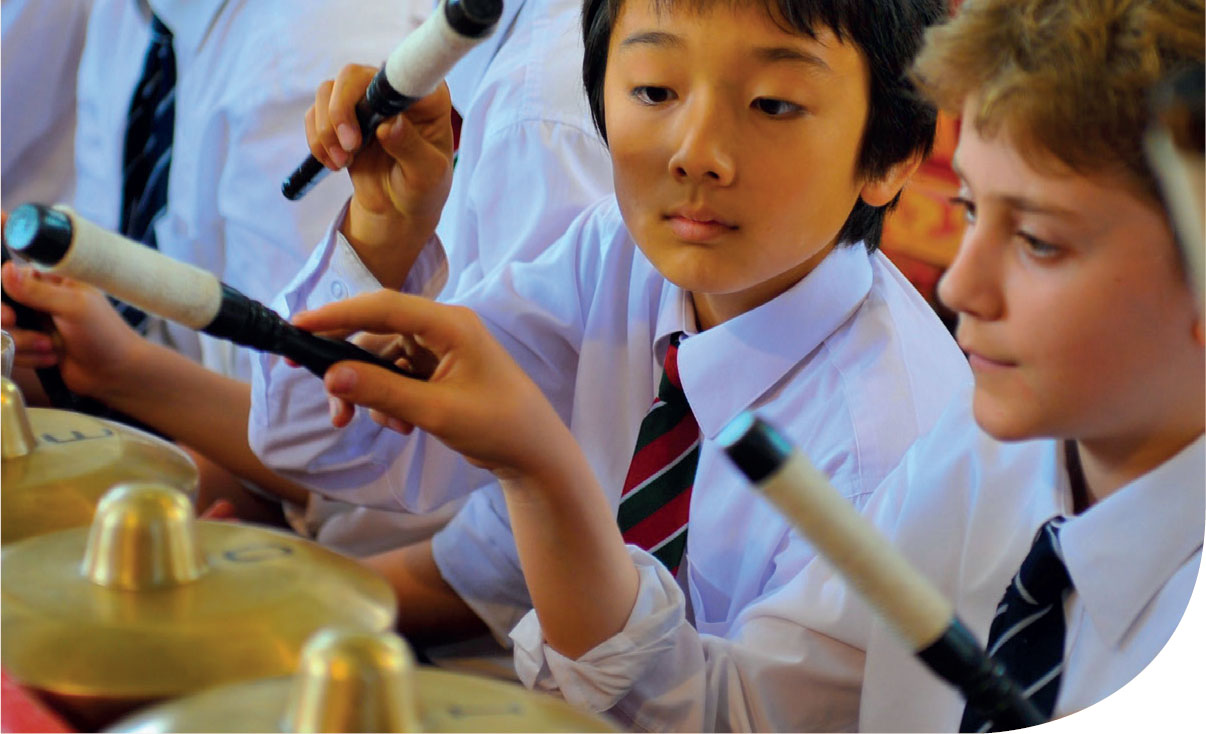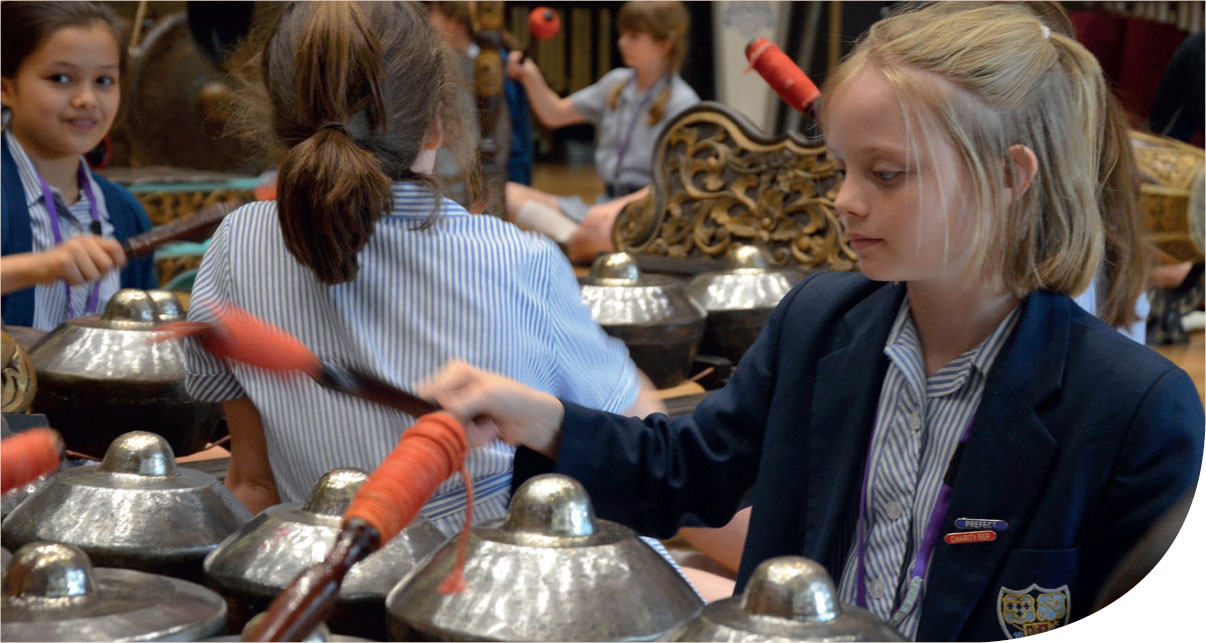
Gamelan, the traditional ensemble music of Indonesia, has long been established as a fantastic musical culture for UK students to experience. It is both accessible and musically appealing, yet different enough from students' everyday musical encounters to provide a fascinating glimpse into another aesthetic world.
Consisting mainly of percussion instruments, the gamelan orchestra offers a fun, hands-on experience suitable for students of all ages. It is no surprise that gamelan is a popular topic for school music lessons, perhaps especially at Key Stage 3.
I come from Java so for me the gamelan tradition isn't ‘different’, but it certainly is special. I spent a six-month residency in the UK earlier this year, inspired by my friends at Jakarta's Indonesia Heritage Society to lead and assist with gamelan workshops in schools across the south of England. I loved sharing my passion for our unique culture, working alongside British students, teachers and musicians who were all generous with their time and amazingly welcoming to someone learning about UK culture and customs.
Among the young students I coached, I discovered a real interest in learning more about gamelan culture, and about Indonesian art forms and ways of life. Many of the teachers I met wanted to integrate gamelan into their curriculum but often lacked the confidence to take the plunge. They felt they needed a bit more knowledge and some practical tips before they were ready to give it a go.
Gamelan: the Basics
So what actually is gamelan? It's an ancient tradition that's still important to modern life in Indonesia. The word gamelan probably comes from gamel, the Javanese term for mallet, and so it makes sense that gamelan instruments typically include drums, gongs and metallophones, sometimes supplemented with flutes and bowed string instruments like the rebab.
The instruments, which are kept together in one place and designed to form a single, indivisible ensemble, are beautifully constructed in metal and wood. They are played by a group of musicians (a sekaha) with the interlocking parts building around simple repetitive patterns. The core melody (balungan) in a piece of gamelan music forms its centre, with other parts building up the texture through elaboration and decoration.
Gamelan is used to accompany important ceremonies as well as dance and shadow puppet theatre (wayang). Although Islam is the majority religion in Indonesia, gamelan has its roots in the Hindu-Buddhist culture and is also commonly used to accompany Roman Catholic rites in modern-day Indonesia.
There are many different sub-traditions of gamelan performance, but the three main types are Javanese, Balinese and Sundanese. While these types share a lot of common aspects, they sound quite different. I like to show UK students the difference between the gentler, lower-pitched, often slower gamelan music of Java and the more energetic, higher, faster style of Bali.
The tuning system used by each set of instruments is unique, making it impossible to exchange instruments between sets, and to ears accustomed to the major and minor scales, gamelan tuning can sound strange. Despite the diversity of precise tunings, there are two main scales: slendro, a pentatonic scale that approximates to C D F G A in Western notation, and pelog, a seven-note scale that approximates to E F G A B C D. Outside Indonesia, the notes of both scales are referred to by number, with pelog using numbers 1 to 7 and slendro using 1, 2, 3, 5 and 6.
If you're setting up classroom percussion instruments as gamelan components, it can be helpful to stick or write numbers on to the notes of the slendro scale, removing unused bars, so that you can teach using this system. A good solution is to choose barred instruments (metallophones, glockenspiels, xylophones) of different sizes and timbres, adding drums and gongs to complete the ensemble. Here are two numbering options to choose between, depending on the range of your barred instruments:
Slendro

Pelog

(Although there are seven notes in the pelog scale, only five are used at a time, effectively making each version of the scale pentatonic.)
Teaching Ideas
Once you've got a set of instruments, you need repertoire and a teaching method. Neither of these is hard, but they're both absolutely essential to classroom success. When choosing your piece, go for something straightforward. My view is that Javanese repertoire is a good starting point, if only because its gentle tempo makes it easier than the Balinese alternatives.
You can find a great deal of good repertoire online, or the English-language texts mentioned in the ‘top resources’ box over the page are a great starting point with lots of easy versions of pieces to choose from. In the UK schools I visited, Lancaran Cobowo in the version published in New Music Matters 11-14 (Heinemann) was the most popular repertoire choice by far, and it was a good one.
Teaching the balungan (core melody) comes first. Everyone needs to be able to play this core melody securely, from memory and in rhythm (even if very slowly) before the learning can proceed further. Break the melody down into smaller chunks and teach it four notes at a time, calling out the numbers as you play. It works well to have students working in pairs, one watching or even pointing at the notes while the other plays. Make sure that students know that this music is cyclic and that maintaining the flow of the music by repeating the balungan without interruption is crucial.
 (Image: Inspire-Works)
(Image: Inspire-Works)
For less able students, this is perhaps as far as they need to go. The great thing about gamelan is that the differentiation is built in. More able students can progress through the parts, adding complexity and building the texture of the piece.
Use your middle-pitched instruments (saron) to keep the balungan steady, add the elaborated melodies in the higher-pitched instruments (peking) and use the low instruments (kenong) to play the slower-moving layer with a reduced number of notes. The reverberation time for real gamelan instruments is very long, so students should practise ‘pinching’ (damping) the previous note as the next is played. The drum (kendang) maintains the pulse, and the gongs punctuate the performance, marking the end of each of the cycles and closing the piece.
As well as performing established pieces, students should be given the chance to create their own balungan core melodies, adding more elaborate and simplified versions to build up the heterophonic texture.
 (Image: Inspire-Works)
(Image: Inspire-Works)
Respecting Gamelan Culture
The teachers I worked with in the UK asked lots of questions, often focusing on ideas about cultural appropriation, and on sensitive ways to represent Indonesian culture in the curriculum. I found myself repeating the same advice again and again, in an attempt to put aside unhelpful myths about the best ways to ‘do’ gamelan in UK schools and to embrace ideas that help young people understand and respect Indonesian culture while sparking an interest in gamelan music.
Here are the five ideas that I found myself saying often. They point the way, I hope, to gamelan as an immersive and accessible experience for UK students, recognising its special status as a traditional and formal musical practice, but also as something that is fun and for everyone.
- Giving students access to authentic, Indonesian-made instruments is the ideal way to experience the tradition, and I encourage teachers to organise visits and residencies that can facilitate this access. But the number of gamelan ensembles in England is limited and so I also warmly encourage the use of classroom percussion instruments to recreate gamelan ensembles. Really good results can be achieved in schools using Orff instruments such as xylophones, metallophones and glockenspiels, supplemented with drums and gongs. I suggest using technology to expose students to the sights and sounds of ‘genuine’ gamelan instruments, and I strongly recommend using correct terminology where possible. It helps to say balungan for the core melody, slendro and pelog for the five- and seven-note scales, and to describe your instruments using the nearest correct names: saron for the middle-pitched instruments; peking for the smaller, higher ones; and kenong for the lower, larger ones.
- Whatever their religion, Indonesians have great respect for the sacred contexts in which gamelan is performed. Students should be aware of this reverence and be trained to follow some of the basic protocols relating to the instruments. Stepping over the instruments should be avoided, as this shows disrespect. Similarly, mallets should always be put down carefully rather than carelessly dropped, and players should take off their shoes and socks. Whether you're using authentic instruments or ones improvised using general classroom percussion resources, playing in bare feet is essential to creating a culturally appropriate pedagogy for gamelan.
- Ultimately, gamelan is a group activity, and building a sense of team spirit is a really important part of teaching gamelan well. Emphasise the teamwork aspect and the importance of listening. This kind of work takes time, so make sure that students have sufficient rehearsals to develop confidence and gain skills as part of the group.
- In Indonesia, the gamelan tradition is normally passed from person to person orally, and is learned by heart. Since notation systems are rare, the introduction of scores and note-reading risks creating a culturally inappropriate pedagogy. What's more, writing things down emphasises a relationship between an individual player and a score, rather than one between all the players and the music. This gets in the way of one of the key aims of the exercise, which is to play together as perfectly as possible. Where students really struggle to learn a note sequence, I find having a friend who is more confident point at the notes is more effective than using a written prompt.
- A lot of teachers feel underconfident in their own knowledge of gamelan. But there are some really great resources available to help those keen to teach gamelan in their schools. Mike Simpson's Teach & Play Balinese Gamelan (Rhinegold Education) is a great starting point if you want to connect with the Balinese tradition. The gamelan modules in Chris Hiscock and Marian Metcalfe's New Music Matters 11-14 (Heinemann) are also well worth a look, and I recommend Andy Gleadhill's Indonesian Gamelan Book (Drums for Schools).
Top Online Resources
-
Lucy Duran's two programmes for BBC Radio 3's World Routes series are both interesting examinations of Indonesian music culture. The first programme explores the music of Java, while the second focuses on the Balinese gamelan tradition (https://www.bbc.co.uk/programmes/b006tnmp).
-
I Wayan Sudirana is a fantastic enthusiast for Balinese gamelan, working all over the world. His lecture-demonstration for the Gita Asmara gamelan collective in Vancouver was filmed in 2013, and is a really good explanation of the basics (http://tiny.cc/Sudirana).
-
The American Gamelan Institute produces two useful online resources. Balungan is an online publication, featuring recordings as well as interesting articles on learning Indonesian music. Gongcast is its podcast, which is well worth a listen.
-
YouTube resources: the great thing about YouTube is that you can show British children examples of kids in Indonesia working on their own gamelan projects, giving them an idea of the styles and functions of the music. There are so many good examples to choose. Have a look at groups preparing music and dance for a school event (http://tiny.cc/Latihan), getting creative with costumes (http://tiny.cc/Barong) or studying in a formal class (http://tiny.cc/Belajar).








